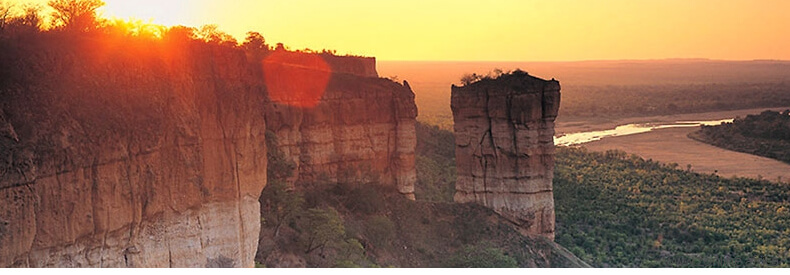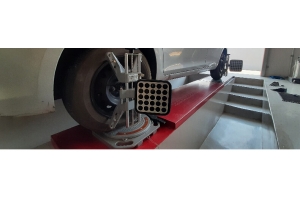We use cookies to make your experience better.
To comply with the new e-Privacy directive, you agree to the privacy policy and our use of cookies.
Gonarezhou: Vast & Magnificent (Part 1)

Chilojo Cliffs is one of Gonarezhou National Park’s main attractions in eastern part of the park
SWEET natural songs composed and produced by wildlife welcome visitors as they pass closely knitted mopane and acacia bushes. Qualia birds churn the soprano as elephants blow the trumpets. Doves tune the alto as baboons seal the wildlife songs with bass. Hot dry climatic conditions are the order of the day. The visitors have spared their ears from the clings-and-dings of town life and have spared their noses from exhaust fumes that rock urban setups.
The above treaty is only reserved for visitors to Gonarezhou National Park. The park was declared a national park in 1975 after being established as a game reserve in the 1960s. It is managed by the Zimbabwe National Parks and Wildlife Authority (ZimParks).
Before the park was established, the area belonged to the Hlengwe people who are a constituency of the Tsonga/Shangaan in Southern Africa. Tsongas/Shangaans are spread in Gaza Province in southern part of Mozambique, northern Limpopo Province and eastern Mpumalanga Province of South Africa and south-eastern parts of Manicaland and Masvingo Provinces of Zimbabwe. To this day, the park is surrounded by Tsonga communities in Chipinge south’s Mahenye area, Chiredzi north’s Sangwe and Chiredzi south’s Matibi 2 and Sengwe areas. Tsonga/Shangaan elders still regard the park as “marhumbini ahina” (our deserted homelands).
Gonarezhou has an area of 5,053 square km making it Zimbabwe’s second largest national wildlife sanctuary after Hwange National Park which has an area of 14,600 square km. Being situated in the south-eastern part of the country where it borders South Africa and Mozambique, Gonarezhou has become part of the “peace parks” project dubbed The Great Limpopo Trans Frontier Park. The Great Limpopo project amalgamates our vast and magnificent park, South Africa's 19,485 square km Kruger National Park and Mozambique’s 10,462 square km Limpopo National Park making the whole area 35,000square km.
The purpose of the peace park is to help market the three destinations as one so that tourists that stay in Kruger may end up visiting Limpopo or Gonarezhou. Also game in the three parks is allowed to roam freely within the three parks.
In Zimbabwe, Gonarezhou is least visited as compared to other smaller parks in the country. Some of the reasons for such include its remoteness from major cities and the unpredictable political instability in the eastern neighbouring country.
The name Gonarezhou is commonly translated as “place of many elephants,” although some elders in the area believe that it has much to do with early traditional herbalists who used elephant tusks as medicine storage known as “gona” in the Shona language. Whatever it means, the area is full of natural treasure.
In addition to the temperatures in the South-Eastern Lowveld which range between 33 and 40 degrees Celsius during hot dry seasons, the region is infested with mosquitoes. It is advisable that visitors bring anti-malaria kits whenever touring the Lowveld. Another serious consideration is that of fuel and provisions. There are no service stations, eating houses or major retail shops in the park save for grocery and bottle stores at business centres around the park.
Gonarezhou isn’t visible when you are using the country’s major highways in the south eastern Lowveld. It’s only when you cross one of the following three huge rivers: Runde, Mwenezi and Save that you are assured of close proximity to the park. The three rivers flow into the park at some point. Runde River and Save River flow near Gonarezhou’s eastern entry point, Chipinda Pools as Mwenezi flows near the park’s southern entry point, Mabalauta.
Chipinda Pools entry point
Chipinda Pools is the headquarters of the eastern sites and is accessible using the Ngundu-Tanganda highway. Chipinda Pools sign post is found at the entry to Malilangwe Wildlife Reserve. To reach Malilangwe entrance, a person from Chiredzi town would have travelled for approximately 24km while one from Mutare/Chipinge direction would have travelled for approximately 33km after crossing Save River at Jack Quinton Bridge. After entering Malilangwe Wildlife Reserve, one has to travel for approximately 36km further off road using an earth road to reach Chipinda Pools. Chipinda’s sub region is at Chinguli.
At Chipinda Pools is where the Runde River widens. Other notable pools along the river include Pokwe, Chitove, Mwatomba and Makonde which visitors can enjoy fishing. A journey towards Runde River’s confluence with Save River takes a visitor past world’s renowned magnificent landmark of red sandstone cliffs known as Chilojo Cliffs. The 170m high cliffs that are at the south bank of the Runde River stretch for more than 30km. They can be beautifully viewed at Hlaro, Fishans and Directors campsites. Two other campsites have been established just opposite the main cliffs.
From there, you arrive at seasonal natural water pans at Tembahata and Machaniwa where bird viewing is ideal. Before it reaches the confluence with Save River, Runde boast of 7m high Chibilila Falls.
What more does the vast and magnificent park offer both at Chipinda and Mabalauta? The part 2 article shall elucidate - check back soon.
Credit: BY STEPHEN EPHRAEM




